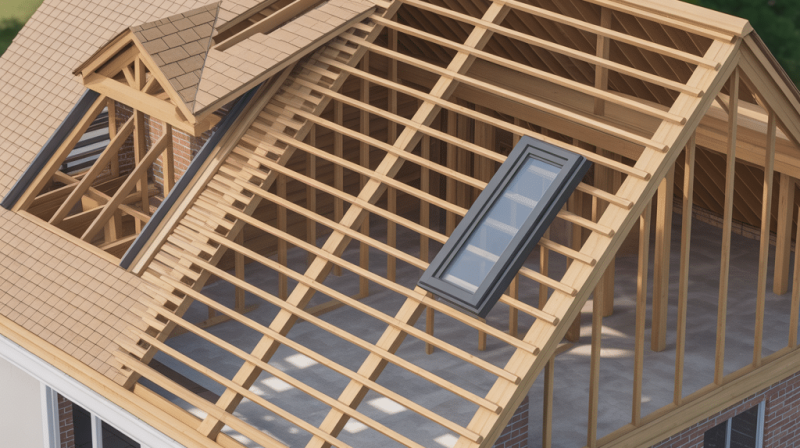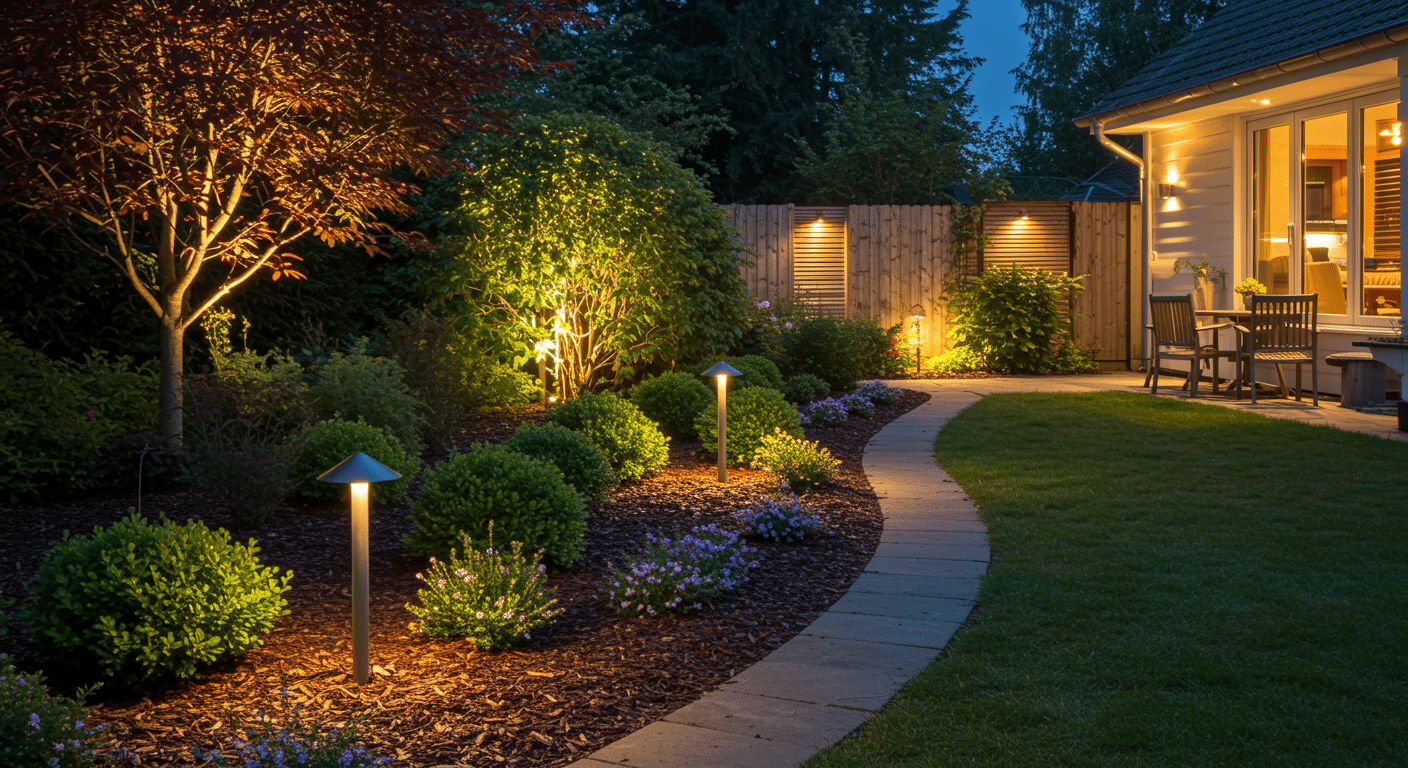Have you ever found yourself nodding along when a contractor mentions “flashing” or “fascia,” but you’re secretly lost? You’re not alone. I’ve been there too.
Roofing conversations can feel like speaking a foreign language. Understanding terminology parts of a roof isn’t just about impressing your neighbors. It’s about making smart decisions for your home.
If you’re planning repairs, talking to contractors, or simply curious about what’s above your head, understanding these terms is essential. And I promise it’s easier than you think.
Let’s break down the roof world together, one term at a time.
Understanding the Basic Roof Structure
Most people think a roof is just shingles. I get it – that’s what we see from the street. However, your roof is a complex system that works together to protect your home.
Think of it like a sandwich. The shingles are just the top layer. Underneath, there’s decking, underlayment, and a whole support structure. Each piece has a job. And each piece has its name.
When contractors talk about your roof, they’re talking about this entire system. Not just the pretty part on top.
Understanding these basic shapes helps. Whether you’ve got a hip roof, shed roof, or something more complex, the same principles apply. The terminology parts of a roof follow patterns once you know what to look for.
Core Roofing Terminology Every Homeowner Should Know
When it comes to understanding the terminology parts of a roof, it’s best to start with the foundational terms. These are the words contractors, inspectors, and roofing brochures throw around; often without explanation.
Let’s break them down by category so you can confidently identify what’s on your roof.
Structural Components
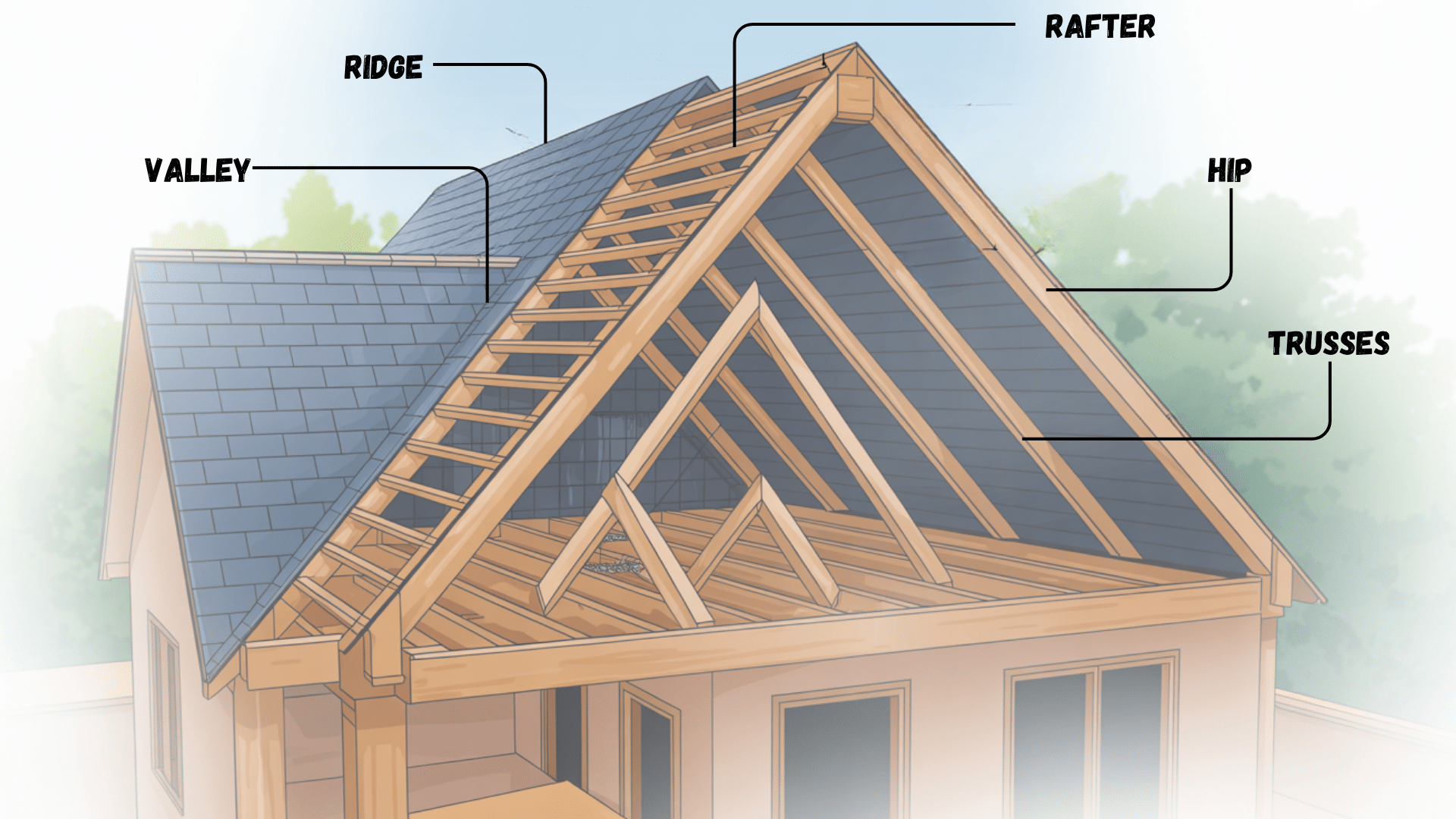
These form the skeletal framework that gives the roof its shape and strength.
| Term | Definition |
|---|---|
| Ridge | The horizontal peak is where two roof planes meet. It runs along the top of a sloped roof and often houses a ridge vent for ventilation. |
| Hip | The external angle is formed where two sloped roof sections meet at the corners. Found on hip roofs, these add strength and help water drain off evenly. |
| Valley | The internal “V” is formed where two roof slopes meet. It’s a channel for directing rainwater into gutters; crucial for drainage and waterproofing. |
| Rafters | Sloped wooden or metal beams extending from the ridge to the eaves. They support the weight of the roof deck and the covering materials. |
| Trusses | Pre-engineered triangular wooden frames that support the roof more efficiently than individual rafters. Commonly used in modern residential construction. |
Edge Elements
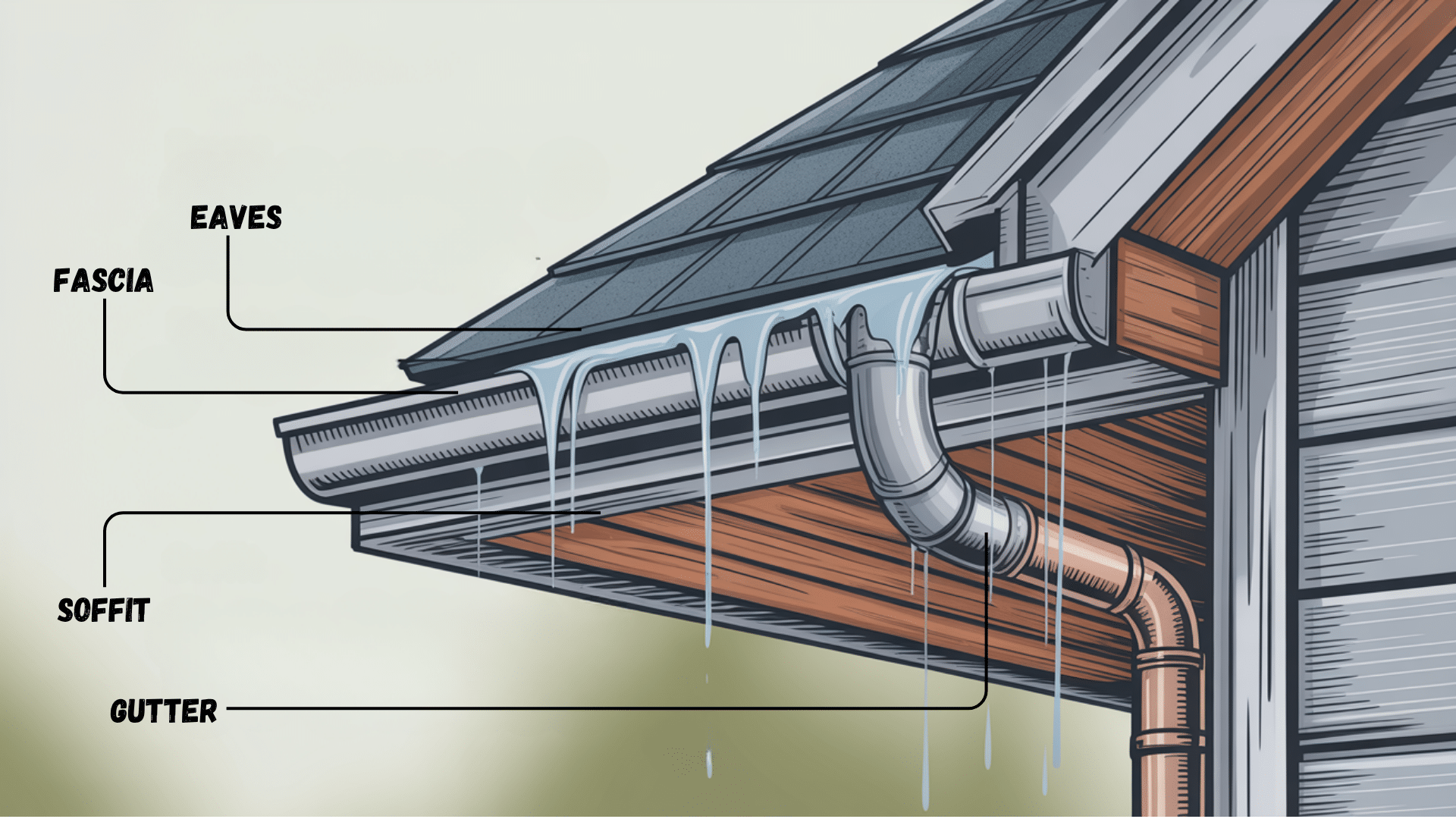
These are the parts that finish and protect the roof’s perimeter.
| Term | Definition |
|---|---|
| Eaves | The lower edges of the roof overhang the walls. They provide shade and channel rainwater away from the foundation. |
| Fascia | A vertical finishing board is attached to the edge of the roof, beneath the shingles, and above the soffit. It’s where gutters are usually mounted. |
| Soffit | The exposed underside of the eaves. It helps ventilate the attic and prevents moisture buildup. |
| Gutter | A channel was installed along the eaves to collect and redirect rainwater away from the house through downspouts. |
Surface and Covering Parts
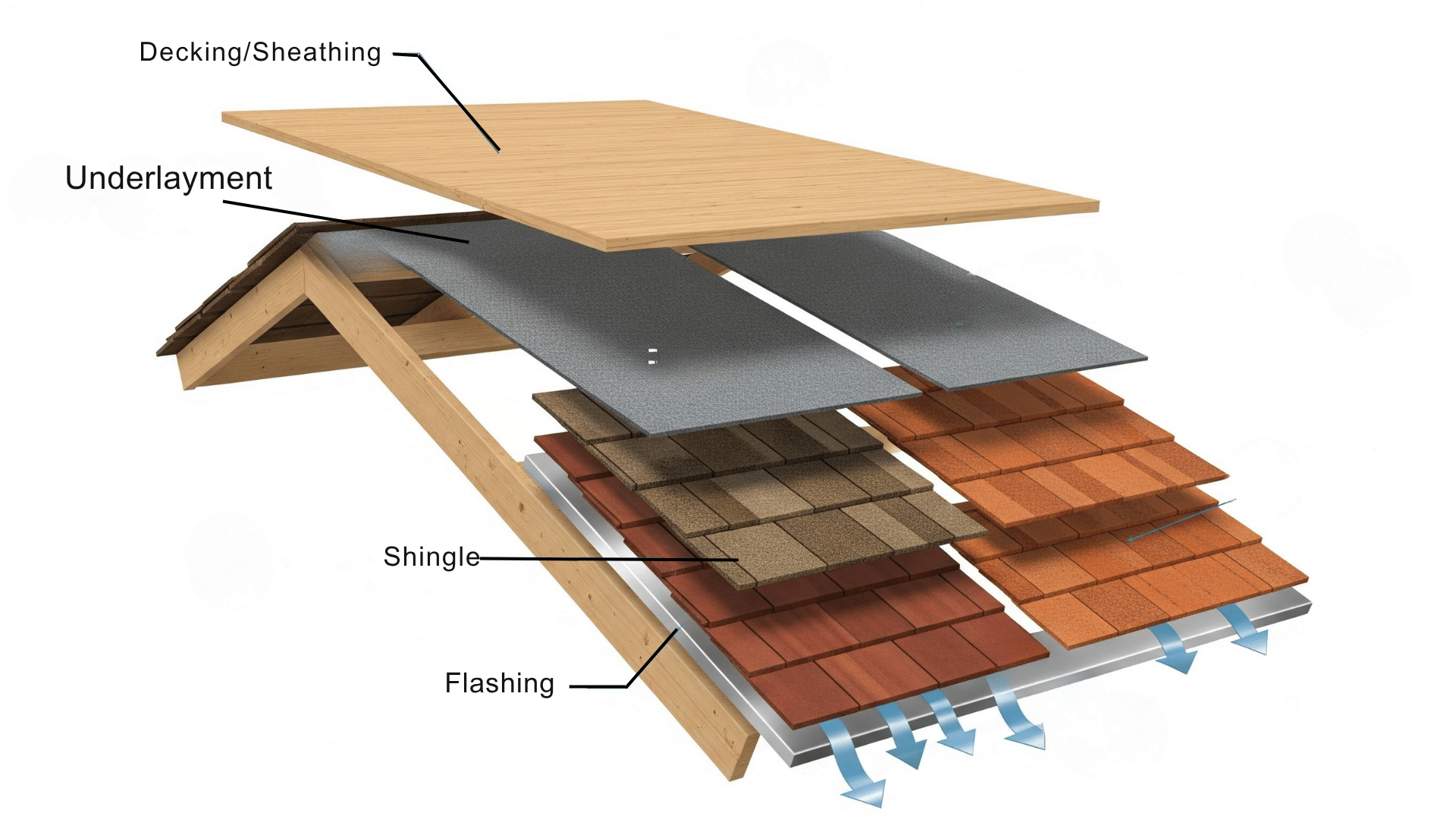
These materials form the visible and protective layer of the roof.
| Term | Definition |
|---|---|
| Decking/Sheathing | The flat surface layer (often plywood or oriented strand board, or OSB) is laid over rafters or trusses, forming the base for underlayment and shingles. |
| Underlayment | A waterproof or water-resistant layer is installed over the decking. It acts as a secondary barrier against moisture. |
| Shingles/Tiles | The outermost protective materials; commonly asphalt shingles, clay, or concrete tiles; shield your home from the elements. |
| Flashing | Thin pieces of metal (like aluminum or galvanized steel) are installed at roof intersections, edges, or around features like chimneys to prevent water intrusion. |
Roof Openings and Add-ons
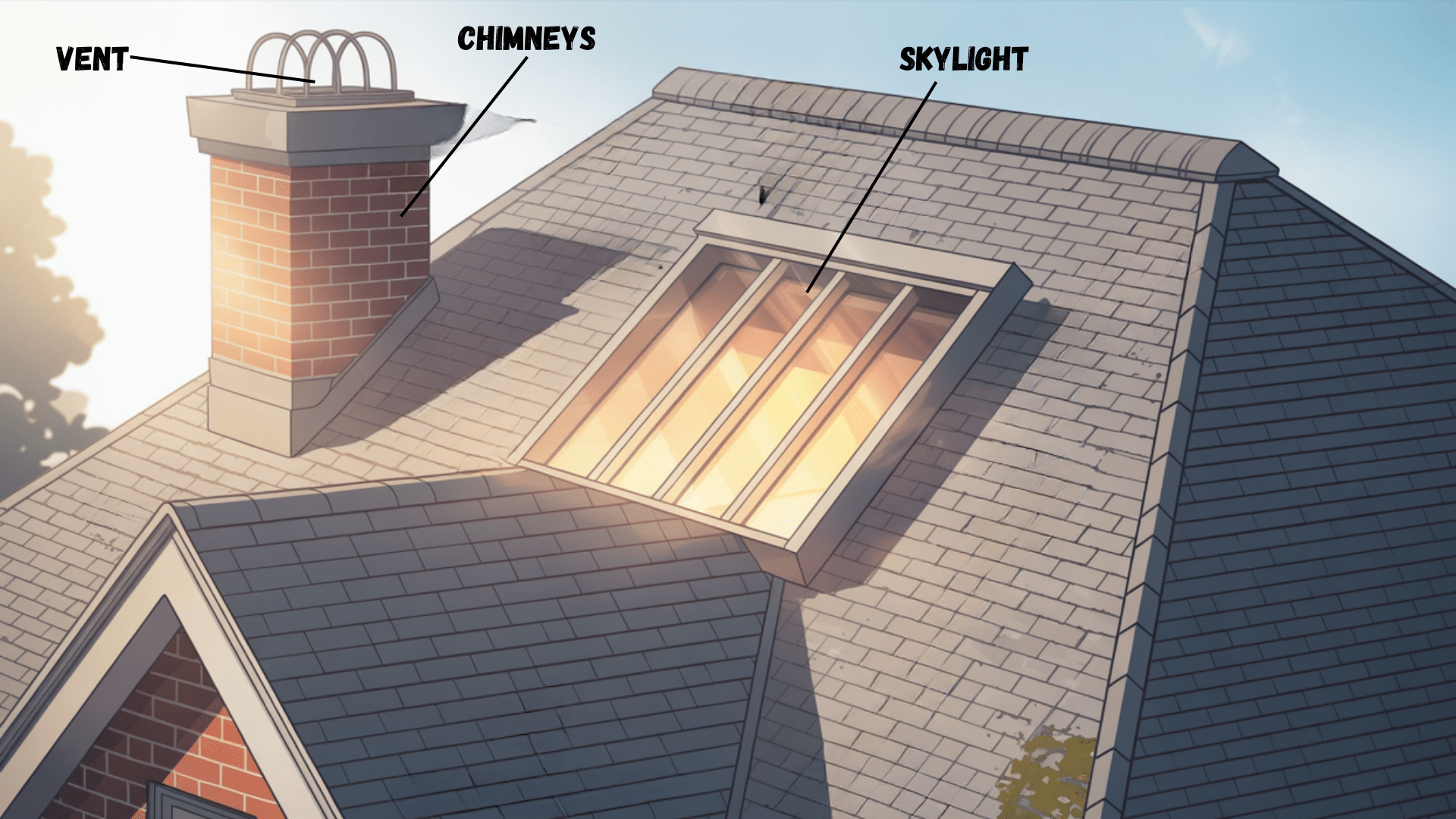
These elements are built into or added onto the roof for functionality and natural light.
| Term | Definition |
|---|---|
| Vents | Ensure proper airflow in the attic and roofing system. Common types include ridge vents, gable vents, and static vents. |
| Skylights | Window-like features are installed on the roof to allow natural light to enter the rooms below. |
| Chimneys and Chase Covers | Chimneys are masonry structures that expel smoke from fireplaces. Chase covers are metal caps placed over chimney chases to prevent water entry. |
Advanced Roofing Terms for the Curious Homeowners
Now that you’ve mastered the essentials, let’s go deeper. These terms aren’t just for pros; they’re for any homeowner who wants to have informed conversations during roof estimates, home inspections, or renovations.
Think of this as your next level of roofing fluency through terminology, parts of a roof.
Water Management Terms
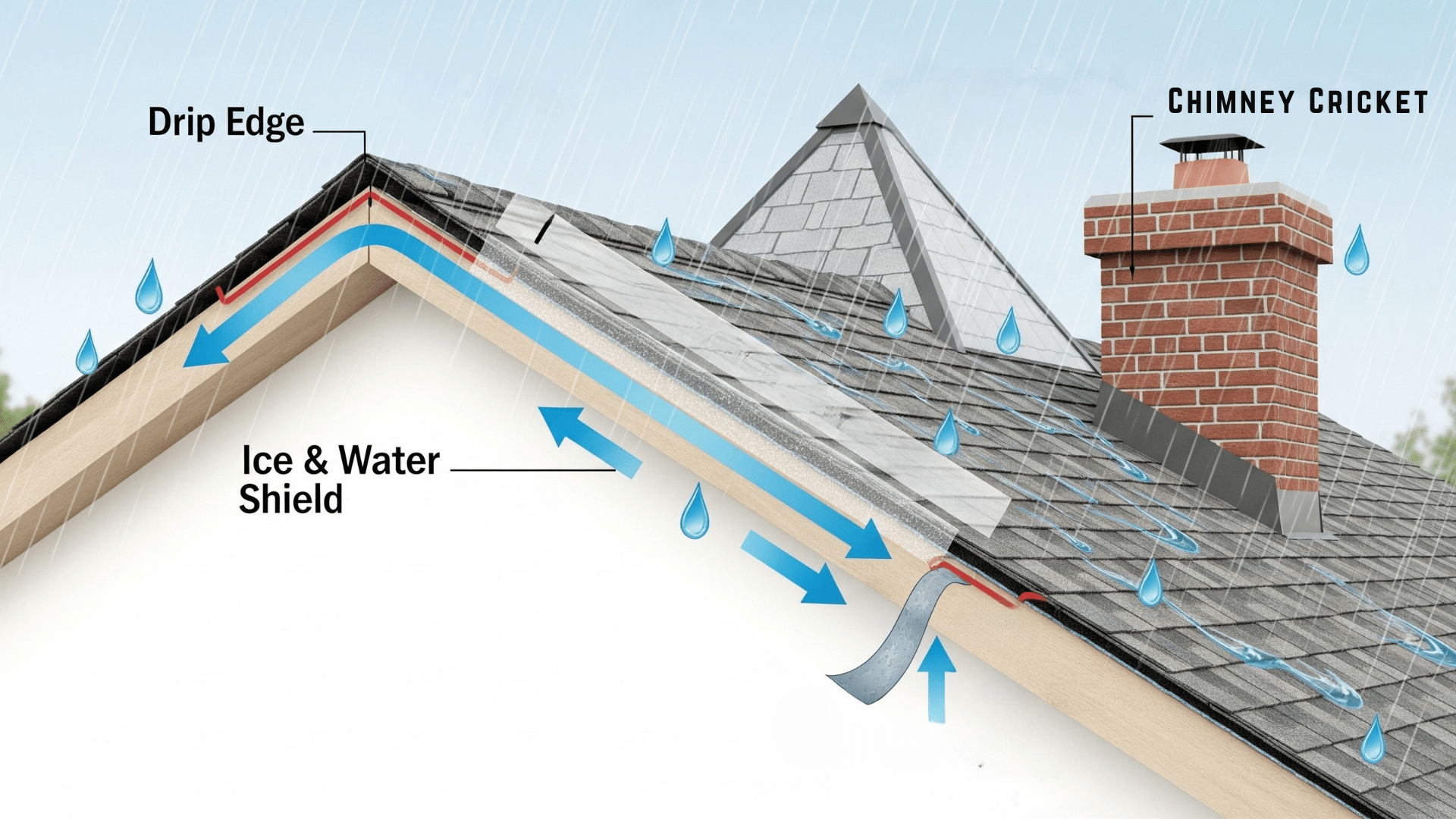
These parts work behind the scenes to keep water where it belongs—off your roof and away from your foundation.
Drip Edge: A metal flashing is installed along the roof’s edges. It directs water into the gutter and prevents it from seeping under the shingles, thereby preventing the deck or fascia from rotting.
Ice & Water Shield: A sticky, waterproof membrane is applied under shingles in vulnerable areas, such as eaves and valleys, to prevent water from entering. It protects against water intrusion caused by ice dams or wind-driven rain.
Cricket: A small, peaked structure is built behind a chimney or dormer to divert water around the base. It prevents pooling and reduces leaks in hard-to-drain spots.
Ventilation & Insulation Terms
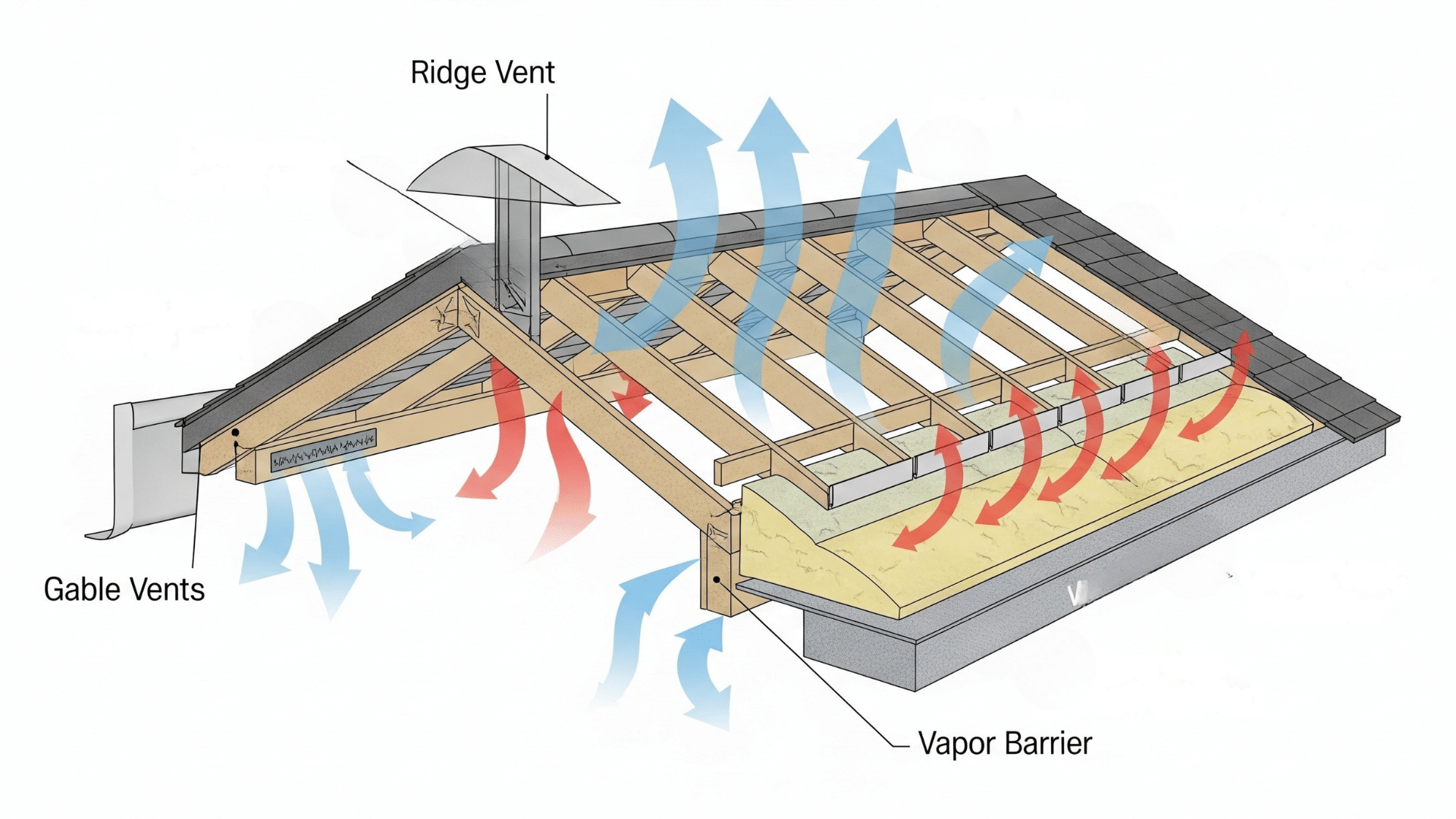
These elements are crucial for roof longevity, energy efficiency, and preventing moisture-related issues.
Ridge Vent: A continuous vent is installed along the roof’s peak (ridge). It allows hot, moist air to escape the attic, promoting balanced airflow.
Gable Vent: A vent is installed in the exterior wall of the attic, usually on the gable ends. It provides additional airflow to help regulate attic temperature.
Baffle: Also known as a rafter vent, this channel keeps airflow clear between the insulation and the roof deck, preventing blockage at the eaves.
Vapor Barrier: A thin material layer that resists moisture diffusion. It’s placed on the warm side of insulation to prevent condensation in attic or roof assemblies.
Slope, Pitch, and Load
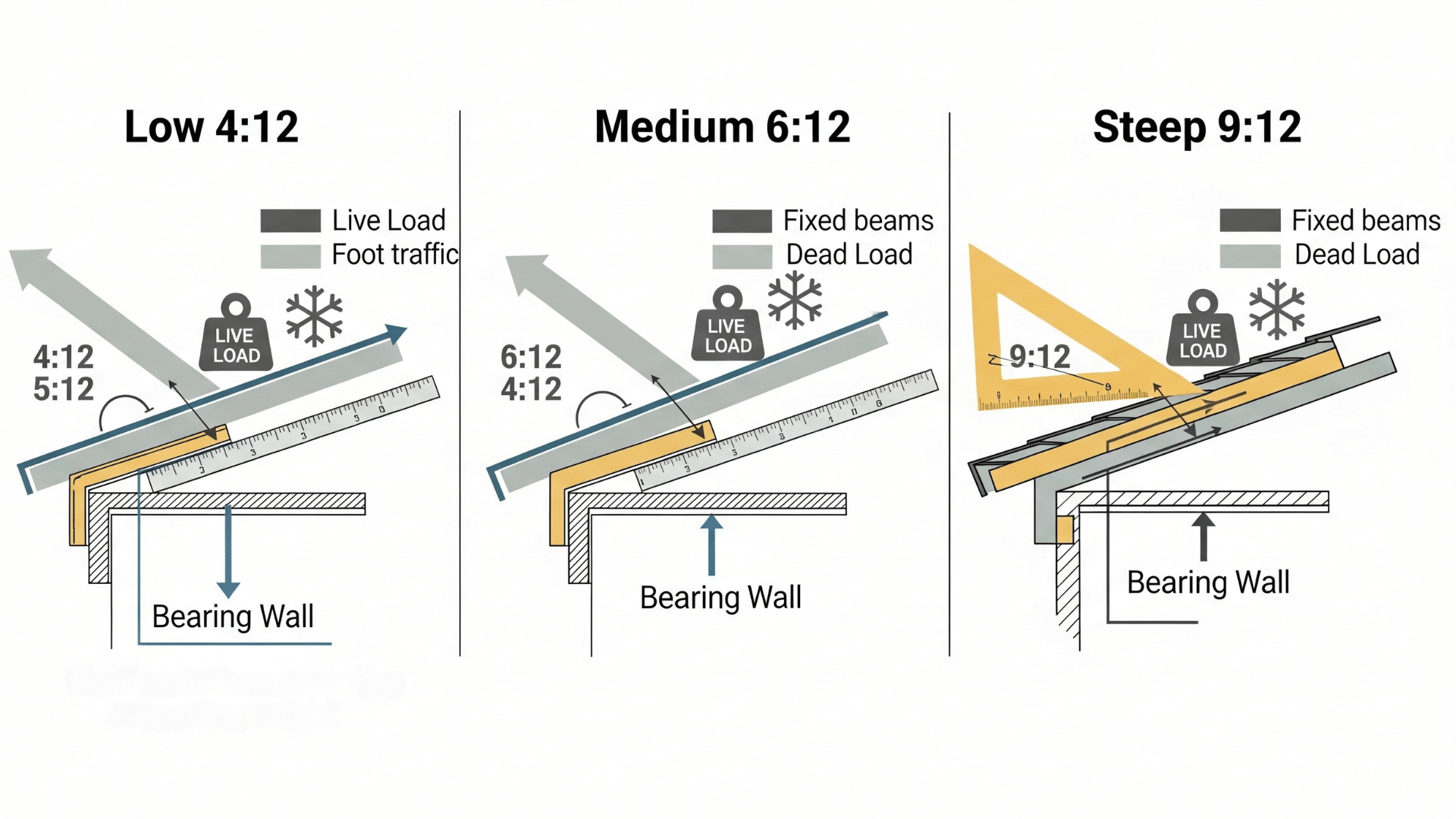
These terms pertain to the structural performance and engineering of the roof, which is particularly crucial in snowy climates or for custom-designed roofs.
Roof Pitch: The measure of a roof’s steepness is expressed as a ratio of rise over run (e.g., 6:12). It affects drainage, shingle type, and even attic space.
Snow Load: The weight of accumulated snow and ice that a roof must support. Local building codes specify requirements based on climate and elevation.
Dead vs. Live Load:
- Dead load: The static weight of the roof system itself; framing, decking, shingles.
- Live load: Temporary weights such as snow, workers, or equipment.
Bearing Walls: Walls that carry the weight of the roof and transfer it to the foundation. Not all walls are load-bearing, but misjudging them can be a structural disaster.
Style-Specific Terminology (For Different Roof Types)
Roofing isn’t one-size-fits-all. The terminology parts of a roof used can vary depending on the style of the roof, such as flat, gable, hip, or shed. Understanding these style-specific parts not only clarifies design conversations but also helps homeowners communicate effectively with roofers or architects. Here’s a breakdown tailored to different roof types.
Flat Roof Terms
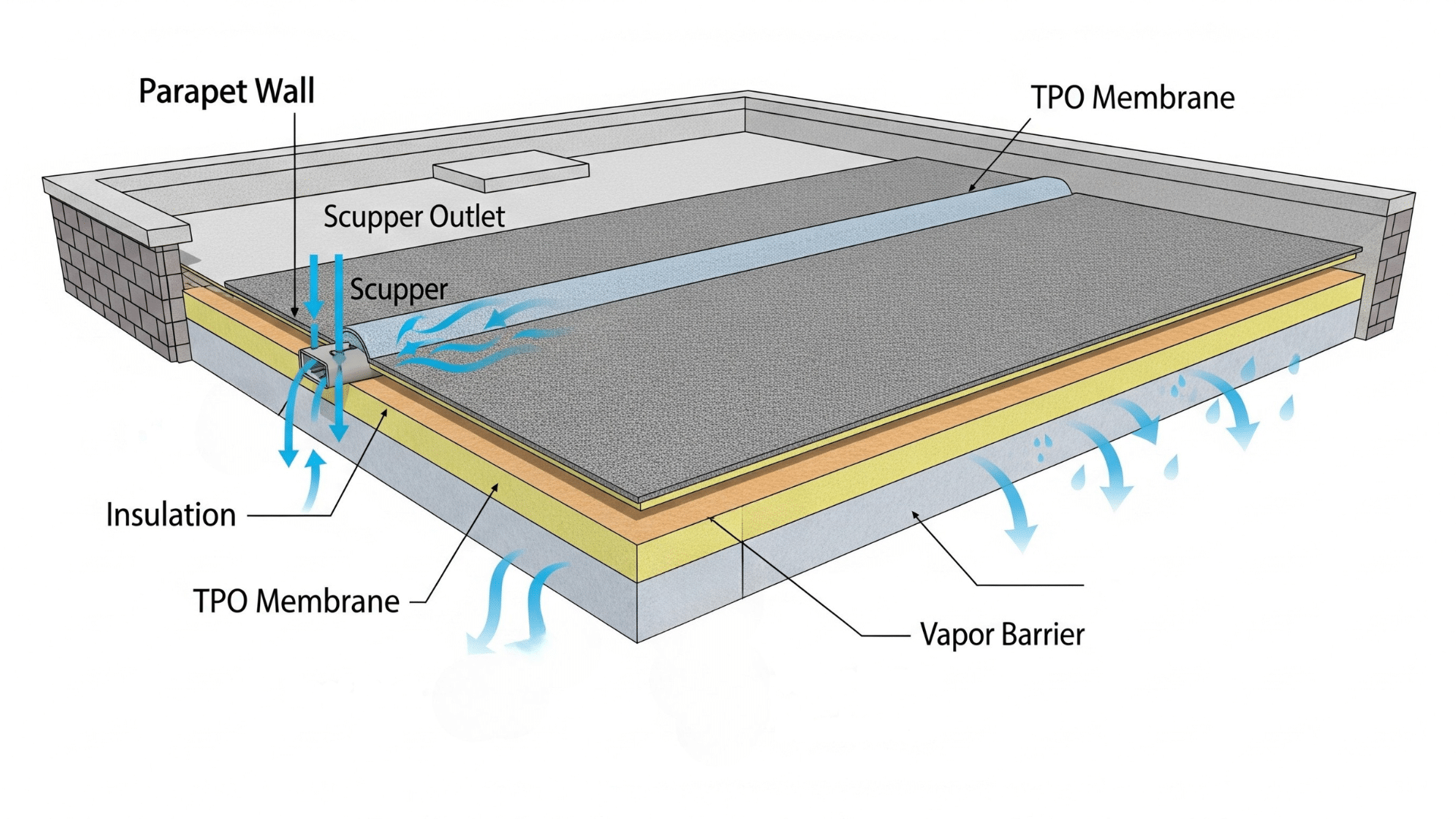
These roofs may appear simple, but they rely on highly engineered components to shed water effectively and maintain their structural integrity.
Membrane: The waterproof layer covers a flat roof. Common types include EPDM (ethylene propylene diene monomer), TPO (thermoplastic olefin), and modified bitumen. It’s essential for sealing the roof against leaks.
Scupper: An opening at the edge of a flat roof that allows water to drain off the surface. Often used in place of gutters, especially in commercial or parapet-walled buildings.
Parapet: A low wall that extends above the roofline along the edge. It adds architectural appeal and safety, especially on flat or low-slope roofs, and often integrates with drainage features.
Gable, Hip, and Shed Roof Variations
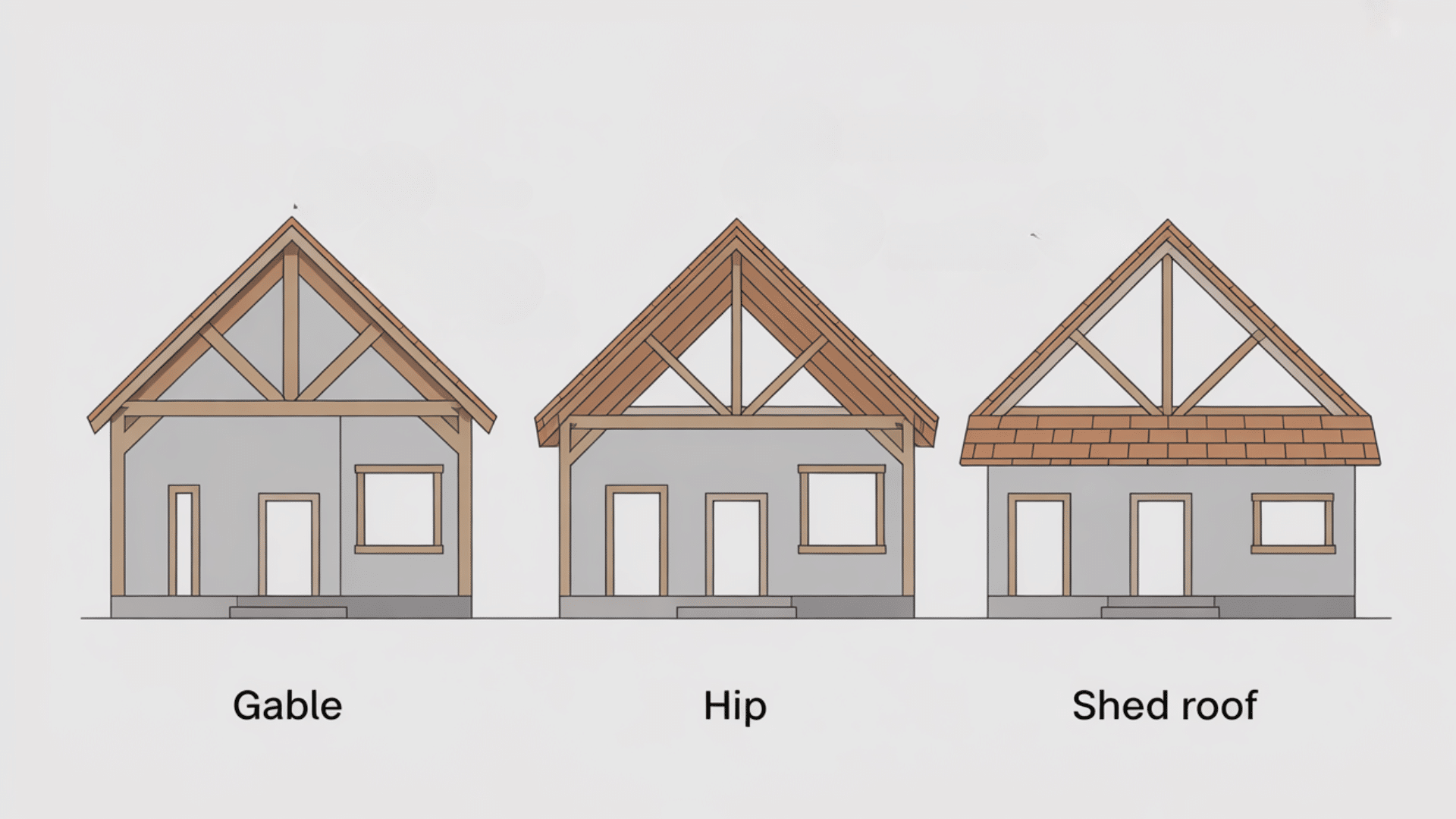
These sloped roof styles introduce unique framing and ventilation elements that aren’t found in flat roofing systems.
Lookouts: Horizontal supports that extend beyond the gable end of a roof to support the roof overhang. They’re part of what gives gable roofs their distinctive shadow line and aesthetic.
Collar Ties: Horizontal framing members that connect opposing rafters near the ridge. They help prevent the roof from spreading and maintain structural integrity during wind or snow loads.
Dormers: Roofed structures that project from the slope of a roof, typically housing a window. Dormers increase usable attic space, add natural light, and offer architectural character.
Common Industry Phrases
Roofers often use shorthand or slang that makes perfect sense if you happen to work in the roofing industry.
For the rest of us, these quick phrases can sound cryptic. This section translates common contractor lingo into plain English, helping you follow conversations without needing a glossary on hand.
Tear-off vs. Overlay
Tear-off involves completely removing old materials before installing new shingles, resulting in higher costs but better long-term durability.
Overlay adds new shingles over existing ones, offering lower upfront costs and a faster installation process.
Roof Square
Roof Square is the standard unit of measurement in the roofing industry, where one square equals 100 square feet of roof area.
This measurement system is crucial to understand because both material costs and labor charges are calculated per square rather than by linear feet.
Flashing Boot
Flashing Boot is a specialized sealing component designed to wrap around roof penetrations, creating a watertight barrier where pipes extend through your roof.
These boots are typically made from rubber, plastic, or metal materials that fit snugly around the pipe to prevent water from seeping into your home at these vulnerable connection points.
Walkability of a Roof
Walkability of a Roof describes how safely and easily contractors can navigate a roof surface without slipping or causing damage to the materials.
Steep-pitched roofs, slate surfaces, and metal roofing typically have low walkability due to their slippery nature or fragile materials.
Nailing Zone or Nail Line
Nailing Zone or Nail Line refers to the specific narrow strip on each shingle where roofing nails must be precisely placed for proper installation.
Proper nail placement is critical because nailing outside this zone can void warranties and lead to serious problems, such as shingle blow-offs during storms or water leaks.
The Bottom Line
I’ve walked you through the essential terminology parts of a roof that make a real difference.
From structural basics to practical applications, you now have the vocabulary to communicate confidently about your roof.
This knowledge isn’t just academic. It’s your tool for better conversations with contractors, smarter DIY decisions, and protecting your investment.
When roof issues arise, and they will, you’ll understand what’s happening above your head.


